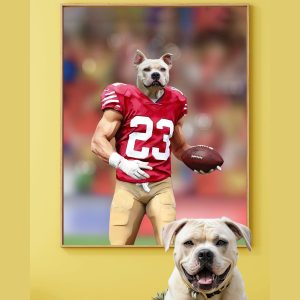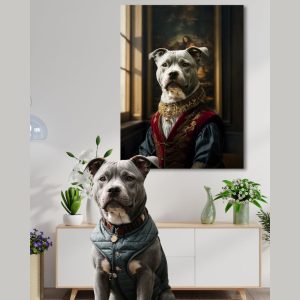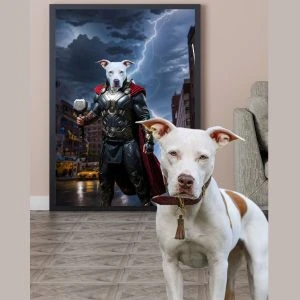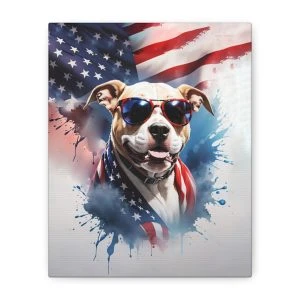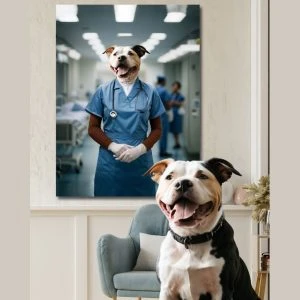Tri-Color Pitbull
What Is A Tri-Color Pitbull?
A Tri Color Pitbull, also known as a Tri-color American PitBull Terrier, is a variation of the American Pit Bull Terrier breed characterized by its coat, which features three colors: black, white, and tan or brown.
These dogs are known for their intelligence, loyalty, and athleticism and are often used as family pets, as well as in various working and sporting roles.
Despite their reputation as fighting dogs, Tri Color Pitbulls are very sensitive and responsive to their owners. They are known to be exposed to their owner’s moods and will often try to cheer them up if they feel down. Pit Bulls are also very trainable and respond well to positive reinforcement training methods, such as treats and praise.
It is crucial to use positive reinforcement to train and discipline Pit Bulls, as they can become anxious and fearful if subjected to harsh punishment or physical correction.
Tri-Color Pitbull Coat Color Genetics: How Does a Tri-Colored Coat Develop?

The coat color of a pitbull, including the tri-color pattern, is determined by genetics. The genes that control coat color are inherited from the dog’s parents.
A pitbull must inherit specific genes from its parents to have a tri-color coat. For example, the gene for the black coat color (B) is dominant over the gene for the red coat color (b).
Likewise, the gene for the tan points (at) is dominant over the gene for the absence of tan points (a).
To have a tri-color coat, a pitbull must inherit the B gene for the black coat color and the at gene for the tan points. In addition, they may also inherit a gene for white markings (S), which can result in white markings on the chest, feet, and face.
However, Merle Pitbull has coats unlike any other tri-colored individual of this breed. Normally, the Merle hue serves as a backdrop adorned with tints of fawn or white that blanket the fur coat.
The specific combination of genes that a pitbull inherits will determine the exact coloring of its coat. For example, a pitbull that inherits the B gene, the at gene, and the S gene will have a black coat with tan points and white markings, resulting in a tri-color skin.
It’s important to note that coat color is just one aspect of a pitbull’s appearance, and it should not be used as the sole factor in determining the quality or value of a pit bull.
Tri-Color Pitbull History and Origin
The American PitBull Terrier, of which the Tri Color Pitbull dogs are a variation, is a breed that was developed in the United Kingdom in the 19th century. Crossing bulldogs and terriers created the species to produce a robust and athletic dog capable of tackling challenging tasks such as herding livestock and hunting small game.
The breed was then brought to the United States, where it quickly gained popularity as a working and sporting dog. Pit Bulls were used for various tasks such as farming, guarding, and ratting and across multiple sporting events such as bull and bear baiting and dogfighting.
As the popularity of these sports declined, Pit Bulls began to be bred more as family pets, and their reputation as loyal and intelligent companions grew.
Today, Pit Bulls are still used as working and sporting dogs but are also commonly kept as family pets. However, due to their history of fighting dogs and the stigma surrounding them, Pit Bulls, including Tri Colored Pitbulls, can face discrimination and breed-specific legislation in some areas.
Tri-Color Pitbull Appearance. How Big Do They Get?
Tri-Color Pitbulls are medium to large-sized dogs with a stocky and muscular build. They typically stand between 17 and 21 inches tall at the shoulder and weigh between 30 and 65 pounds, with males typically being more significant than females.
In terms of coat color, Tri Color Pitbulls can have a variety of coat patterns and color combinations, but they are most commonly black, white, and tan or brown. Some Tri Color Pitbulls may also have a small amount of brindle in their coat, a pattern of black or brown stripes on a lighter background color.
Tri-Color Pitbulls have a short, smooth coat that is easy to groom and maintain. They shed, but not excessively, and regular brushing with a slicker brush will help remove loose hair and keep their coat looking clean and shiny.
In addition, it is vital to keep their nails trimmed regularly to prevent them from getting too long and to brush their teeth at least once a week to maintain good dental health.
Tri-Color Pitbull Temperament and Personality
Throughout my years as a dedicated Pitbull advocate, I’ve had the joy of sharing my home with several spirited Tri-Color Pitbulls, each bursting with personality. Let me tell you, no two days are ever the same with these vibrant canines, and here’s why:
One of the most heartwarming traits of Tri-Color Pitbulls is their profound sensitivity to human emotions. I recall a particularly tough day when I was sitting on my porch, lost in thought, and Luna, my oldest Tri-Color, gently nuzzled her way onto my lap. It was as if she understood my mood without a word being spoken. These dogs don’t just sense your feelings; they respond with a kind of empathy that’s rare in the animal kingdom.
Now, if you’re new to the world of Pitbulls, you might have heard stereotypes that paint them as aggressive or unruly. In my experience, this couldn’t be further from the truth, especially with the right approach to training. I’ve always used positive reinforcement with my pups, and the results have been nothing short of remarkable. Take Zeus, for instance, my youngest. He used to be quite the jumper, but with consistent rewards and gentle guidance, he’s now the most well-mannered gentleman at the dog park.
But it’s not all about discipline. Tri-Color Pitbulls are a playful bunch, brimming with energy and always up for a game of fetch. My Daisy loves her frisbee more than any treat you could offer her. And when they’re not playing, they’re by your side, loyal companions through and through.
It’s important to understand that these dogs crave companionship and thrive on being part of your day-to-day life. They’re not the type to be left alone in the backyard; they want to be where you are, involved in what you’re doing – be it gardening, watching TV, or in my case, even while I’m writing this article!
Tri-Color Pitbull: Training and Exercise
Understanding the essentials of training and exercise is fundamental to the well-being of your Tri-Color Pitbull. These vibrant canines thrive on mental stimulation and physical activity, and here’s how you can meet their needs effectively:
Positive Reinforcement Training
Tri-Colors are keen learners but require a consistent, reward-based approach. Keep training sessions short and fun, focusing on one command at a time. Whether it’s ‘sit,’ ‘stay,’ or ‘come,’ positive reinforcement with treats or praise makes them eager to comply. And don’t shy away from mental games — a session of hide-and-seek or a new puzzle toy can be both entertaining and mentally stimulating for them.
Physical Exercise
A daily walk is a must, but Tri-Colors often crave more active engagement. Incorporate activities like running, agility training, or even frisbee into their routine to help them burn off excess energy. But remember, it’s not just about tiring them out; it’s about spending quality time together and strengthening your bond.
Socialization Is Key
Early and diverse socialization experiences are crucial. Regular visits to dog parks or participation in community events help them become well-adjusted adults. Positive interactions with various people and pets contribute immensely to their social skills.
In essence, a well-trained, well-exercised Tri-Color Pitbull is a happy and loyal companion. While it does require commitment, the joy and companionship you’ll receive in return are beyond measure.
Health and Lifespan of Tri-Color Pitbulls
Tri-Color Pitbulls are known for their robustness, but like any breed, they’re prone to certain health conditions. Understanding these is crucial for any responsible owner, as it helps ensure a long, happy life for your furry friend.
Common Health Issues
Hip dysplasia is a prevalent concern, not just in Pitbulls but in many breeds. It’s a genetic condition where the ball and socket of the hip joint don’t develop properly, leading to pain and arthritis. According to the American Kennel Club, while it’s more common in larger breeds, it can occur in any size or breed of dog. Early diagnosis and treatment are crucial; options range from lifestyle modifications to surgery, depending on severity.
Another issue is allergies, which can cause skin irritation, itching, and ear infections. They can be due to food or environmental factors like pollen or dust mites. Regular check-ups can help identify the cause and manage symptoms.
Heart disease, particularly aortic stenosis, can also affect Pitbulls. Regular veterinary screenings are essential for early detection and management.
Lifespan
Tri-Color Pitbulls typically enjoy a lifespan of 12-14 years. However, this can vary due to factors like genetics, health, diet, and exercise. Regular veterinary care, a balanced diet, and daily exercise are vital for a long, healthy life.
Preventative Care
Prevention is always better than cure. Regular vaccinations and parasite control are non-negotiables. A balanced diet, regular exercise, and mental stimulation also contribute significantly to overall health.
Regarding hip dysplasia, the AKC suggests that “keeping your dog’s skeletal system healthy should start when your dog is young.” They recommend a proper diet, especially for large-breed puppies, to prevent excessive growth leading to skeletal disorders. Moreover, obesity is a significant factor contributing to hip dysplasia, so maintaining an appropriate weight is crucial.
Dr. Jerry Klein, Chief Veterinary Officer of the AKC, emphasizes the importance of early screening for hereditary conditions. He states, “The best way that breeders can prevent hereditary hip dysplasia is to screen their breeding dogs for the disease.” This screening helps ensure healthier generations of Pitbulls.
While Tri-Color Pitbulls are generally healthy dogs, they’re not immune to health issues. As an owner, staying informed about these conditions, ensuring regular veterinary care, and maintaining a healthy lifestyle are your best bets in guaranteeing a long, happy life for your Pitbull.
Effortless Grooming: Simplifying Care for Your Tri-Color Pitbulls Coat
One of the many joys of owning a Tri-Color Pitbull is their low-maintenance grooming needs, thanks to their short, sleek coat. However, even with their hassle-free fur, a regular grooming routine is essential to keep your Pitbull looking their best and maintaining overall health.
Regular Brushing
Despite their short hair, Tri-Color Pitbulls do shed. I’ve found that a weekly brushing session is sufficient to keep loose hair under control. It’s a great bonding activity, too — my Tri-Color, Rex, sees his brush and comes running over with a wagging tail! A rubber grooming mitt or brush designed for short-haired dogs works wonders in removing loose fur and stimulating the skin.
Bathing Needs
Tri-Colors don’t require frequent baths — once a month or when they get dirty is typically enough. Overbathing can strip their skin of natural oils, leading to dryness and irritation. Always use a dog-formulated shampoo, and consider one designed for sensitive skin if your Pitbull is prone to allergies.
Skin Care
Their short coat means their skin is more exposed, so check regularly for any signs of irritation, especially if your Tri-Color has allergies. During our grooming sessions, I make it a point to check Rex’s skin for any rashes, redness, or signs of discomfort.
Nail Trimming
Regular nail trims are necessary to prevent discomfort and potential issues with walking. If you hear their nails clicking on the floor, it’s time for a trim. I’ve trained Rex to associate nail trimming with positive rewards, making the process easier for both of us.
Ear Cleaning
Clean their ears regularly to prevent infections, especially if your Tri-Color loves water activities. Use a vet-recommended ear cleaning solution and avoid inserting anything deep into the ear canal.
Dental Health
Don’t overlook dental care. Regular brushing and dental treats help prevent tartar build-up and dental issues. Rex knows after our brushing sessions, he gets his favorite dental chew — it’s routine for him now!
As you can tell, grooming your Tri-Color Pitbull is more than an aesthetic chore; it’s a fundamental aspect of their health and well-being. Plus, it’s a beautiful way to strengthen your bond. With these simple care tips, your Tri-Color will not only look good but feel great too!
Tri-Color Pitbull Puppies
Tri-Color Pitbull puppies are adorable and energetic, and they can make great companions for suitable families. However, if you are considering adopting a Tri Color Pitbull puppy, it is crucial to be prepared for raising a young dog.
Pitbull puppies, like all puppies, require a lot of time, attention, and training to ensure that they grow up well-behaved and well-adjusted adults. This includes providing socialization, training, and exercise, feeding them a balanced diet, and ensuring they receive proper medical care.
Raising a Tri Color Pitbull puppy can be a lot of work, but it can also be a rewarding and enjoyable experience. With the proper care and training, Tri Color Pitbull puppies can grow into loyal, intelligent, and affectionate dogs that make great companions.
The cost of adopting a Tri Color Pitbull puppy will depend on the specific puppy and the breeder or organization you are working with. Prices can vary widely, with some puppies being available for a few hundred dollars while others may cost several thousand dollars. Therefore, it is vital to research and be prepared to cover the ongoing costs of raising a Tri Color Pitbull puppy, including food, vet care, and training.
Do Tri-Color Pitbull Puppies Change Color as They Grow?
Pitbull puppies, including those with tri-color coats, may undergo some changes in coat color as they grow and mature. However, these changes are usually subtle and may not be noticeable to the casual observer.
During the first few weeks of life, pitbull puppies may have a coat that is lighter in color than their adult coat will be. Then, as they grow and their adult coat starts to come in, their coat color may become slightly darker or more intense.
In some cases, the white markings on a pitbull’s coat may become more pronounced as they grow, while in other cases, they may become less noticeable.
This can happen because the white hairs may become longer or thicker, or the surrounding black or tan hairs may shed out, making the white markings more visible.
Overall, it is normal for pitbull puppies to undergo some changes in coat color as they grow and mature, but these changes are usually not significant and will not drastically alter the overall appearance of the dog.
Adopting a Tri-Color Pitbull: Making Informed Choices
Embarking on the journey of adopting a Tri-Color Pitbull is exciting but requires careful consideration and informed decision-making.
Know What You’re Looking For: Identify reputable breeders or adoption centers known for their ethical practices. They should be transparent about the dog’s health history and open to your visitations. Remember, responsible breeders prioritize the dogs’ well-being over profit.
Ask the Right Questions: Prepare a list of questions about the Pitbull’s health, behavior, and lineage. Inquire about any genetic health conditions, the parents’ temperament, and the environment they were raised in. Don’t forget to ask for necessary health certifications.
Understand Their Needs: Tri-Color Pitbulls are energetic, affectionate, and require a committed owner. Ensure you’re ready to provide ample exercise, training, and love. Their loyalty is unmatched, but they thrive on strong bonds and consistent routines.
Consider Rescue: Many wonderful Pitbulls are waiting in shelters for a loving home. Rescuing a dog can be a rewarding experience, giving them a second chance they deserve. Plus, shelters often cover initial veterinary care, making it a viable option.
Legal and Community Aspects: Be aware of local regulations regarding Pitbull ownership. Unfortunately, breed-specific legislation exists in some areas. Also, consider your living situation — do you have enough space, and does your community welcome Pitbulls?
Post-Adoption Care: Plan for their arrival by setting up a comfortable space, scheduling a veterinary check-up, and establishing a routine. Consistency helps your new companion feel secure and loved in their new environment.
Adopting a Tri-Color Pitbull is a life-changing journey of companionship. It requires diligence, understanding, and an open heart. Whether you opt for a breeder or decide to rescue, always remember, you’re gaining a loyal friend.
Tri-Color Pitbull Price: How Much Are Tri-Color Pitbulls?
The cost of adopting a Tri Color Pitbull will depend on the specific dog and the organization or breeder you are working with. Adoption fees at animal shelters and rescue groups may range from $50 to $500, while the cost of purchasing a Tri Color Pitbull from a breeder can vary widely, with prices ranging from a few hundred dollars to several thousand dollars.
It is essential to remember that the initial cost of adopting a Tri Color Pitbull is only a tiny part of the overall cost of owning a dog, and you should be prepared to cover ongoing expenses such as food, vet care, and training. These expenses depend on the dog’s size, age, and health status.
When adopting a Tri Color Pitbull, it is essential to research and choose a reputable organization or breeder. This will help ensure that you get a healthy, well-adjusted dog that has been adequately cared for.
Also, consider adoption from a local animal shelter or rescue group, as this can help support these organizations’ efforts and give a deserving dog a second chance at finding a loving home.
Level of Experience Necessary To Own a Tri-Color Pitbull
Owning a Tri-Color Pitbull is a rewarding experience, yet it comes with its unique set of challenges, especially for novice dog owners. These dogs are known for their strong bonds with their owners, requiring at least 2 hours a day of quality time, failing which they might become depressed or destructive. Their intelligence and energy are commendable, but without the proper outlet, these traits can lead to behavioral issues.
Professional trainers emphasize the importance of understanding your Pitbull’s behavior. “Pit Bulls can be escape artists, capable of climbing tall fences or digging their way out,” notes a source from Lane County Animal Services. This agility means they need secure spaces and constant supervision. Moreover, their athletic nature requires owners to engage in activities like agility work, flyball, or other dog sports.
One significant aspect that new owners might find challenging is their dog’s interaction with other animals. While some Pit Bulls are very dog-friendly, others may have selective dog tolerance or even dog aggression. Understanding and respecting your dog’s personality is crucial in managing their interactions with other animals. Regular socialization, especially from a young age, can help mitigate some of these issues, but owners should be prepared for the possibility that their Pitbull might not get along with every other dog.
Furthermore, Pit Bulls often face societal prejudice due to misconceptions about the breed. Owners should be prepared for a range of reactions, from fear to admiration, when out with their dog. Responsible ownership, including obedience training, socialization, and understanding dog body language, is crucial to help change public perception and ensure both your dog’s and the public’s safety.
Always remember, while Tri-Color Pitbulls make loyal and loving pets, they are best suited for owners who can provide firm, consistent training, plenty of exercise, and socialization. First-time dog owners should be prepared to invest time in learning about the breed and possibly working with a professional trainer to ensure a harmonious and safe relationship with their pet.
Are Tri-Color Pitbulls Rare? Understanding the Spectrum of Colors
The allure of the Tri-Color Pitbull lies not just in their robust physique and captivating personality but also in the rarity and beauty of their coat colors. But, are Tri-Color Pitbulls rare? The answer lies in genetics and the understanding of coat color inheritance in this breed.
Tri-Color Pitbulls are indeed less common than their single or bi-colored counterparts. Their unique coat is attributed to specific recessive genes that need to be present in both parents to produce a Tri-Color litter. The rarity comes from the fact that these genes are less commonly found in the Pitbull gene pool.
The Fascinating Palette of Tri-Color Pitbulls
Understanding the spectrum of colors available in Tri-Color Pitbulls is essential for enthusiasts and potential owners. Each color variation not only contributes to the aesthetic appeal but also indicates the rarity due to specific genetic combinations.

Blue Tri Color Pitbull
The enchanting Blue Tri has a grayish coat, with shades varying from deep charcoal to a light silvery hue, complemented by the classic tri markings. Their rarity makes them highly sought after, but it’s their warm, playful temperament that wins hearts.
Black Tri Color Pitbull
Majestic in their appearance, Black Tri Pitbulls have a predominant black coat with the signature tri-pattern markings. Their striking contrast is a sight to behold, making them a rare and prized color variation.
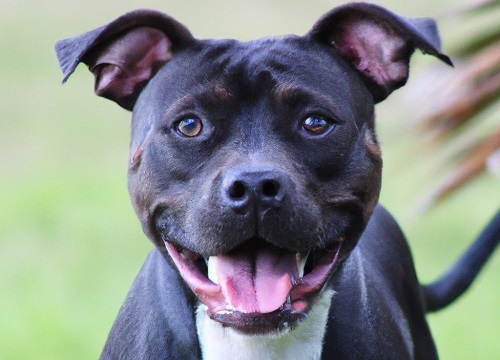

Chocolate Tri Pitbull
With their rich, deep brown coloring, Chocolate Tri Pitbulls are a delightful sight. This coloration is less common, making them a rare find among Pitbull enthusiasts.
Fawn Tri Color Pitbull
Exhibiting a beautiful mix of light tan to a dark reddish hue, the Fawn Tri-Color Pitbulls carry an air of elegance. Their distinctive markings add to their charm, making them a beloved yet uncommon variant.


Purple Tri Color Pitbull
Perhaps the rarest, the Purple Tri Color Pitbull isn’t actually purple but rather a unique shade of deep blue, giving off a purplish appearance. This color’s scarcity is due to the specific genetic combination required, making them an extraordinary sight.
Each of these colors has its own unique genetic makeup, contributing to their rarity. It’s important to note that while coat color adds to a dog’s visual appeal, it does not define their personality or health. A Pitbull’s worth is in its character, loyalty, and the love it brings to a family.
While Tri-Color Pitbulls are less common due to the specific genetic combinations required, their rarity doesn’t diminish their value as a breed. They are, first and foremost, loving, loyal, and playful dogs, regardless of the color of their coat.
Final Thoughts
The Tri-Color Pitbull has become a popular dog in the United States, and it’s no surprise why. This unique dog has earned its place in the hearts of many canine lovers with its playful and loyal nature. While not officially recognized by the American Kennel Club (AKC) as a distinct breed yet, tri-color Pitbulls are still beloved by their owners.
Though some tri-color Pitbulls may have unique markings on their coats due to being “merle” patterns, there is no consensus among experts on whether the AKC should give these dogs official recognition. Regardless of this debate, however, one thing remains true: these canines are adored by their families for their endearing personalities and gorgeous coats!
Our website is all about Pitbulls. If you’re a Pitbull lover and looking for more information about Pitbull colors, you’re in the right place. Discover more about the Panther Black Pitbull, Grey Pitbull, Black Pitbull, Brown Pitbull, Black & White Pitbull, and many others. We frequently update this page. Please bookmark it and check back soon!

Mandy has lived with pitbulls her whole life, and she has amassed a wealth of experience and knowledge about these magnificent animals. Having had the pleasure of owning and caring for numerous pitbulls over the years, she has come to understand their unique characteristics, behaviors, and needs. Read more

















